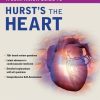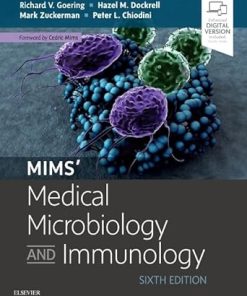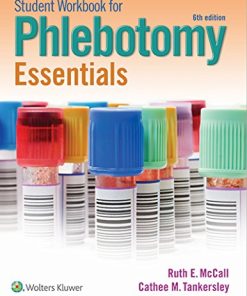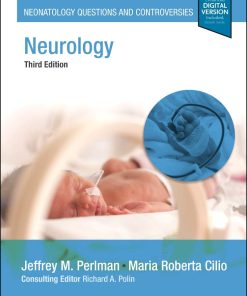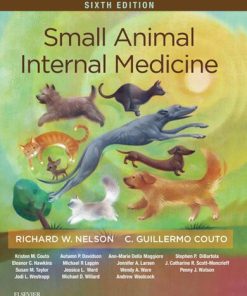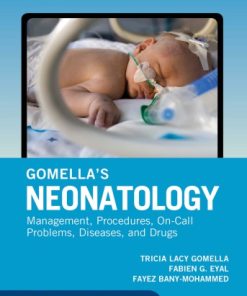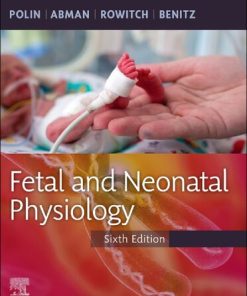(Ebook PDF) Workbook in Practical Neonatology 6th Edition by Richard Polin 0323624812 9780323624817 full chapters
$50.00 Original price was: $50.00.$25.00Current price is: $25.00.
Workbook in Practical Neonatology 6th Edition by Richard A. Polin – Ebook PDF Instant Download/DeliveryISBN: 0323624812, 9780323624817
Full dowload Workbook in Practical Neonatology 6th Edition after payment.
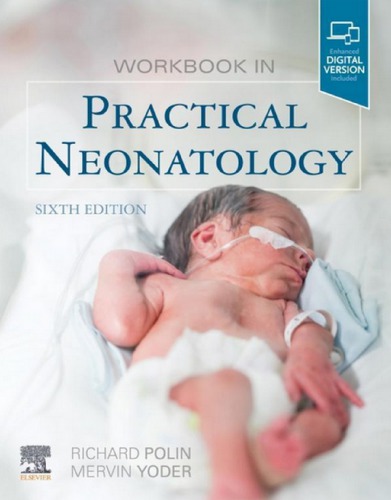
Product details:
ISBN-10 : 0323624812
ISBN-13 : 9780323624817
Author: Richard Polin
Workbook in Practical Neonatology
Workbook in Practical Neonatology 6th Table of contents:
1. A physiologic approach to neonatal resuscitation
Introduction
Establishing pulmonary ventilation
Case 1
Case 1 continued
Airway liquid clearance before birth and during labor
Sustained inflation during resuscitation
Case 1 continued
Case 1 continued
Facilitating the cardiovascular transition at birth
Managing the asphyxiated infant
Case 2
Summary
References
2. Perinatal hypoxia-ischemia
Stabilization following possible perinatal asphyxia
Case 1
Diagnosis—a contrast of 2 cases
Case 2
Supportive management following perinatal asphyxia
Case 3
Hypothermia therapy
Case 4
Case 5
Controversies in hypothermia therapy
References
3. Fluid and electrolyte management in the newborn intensive care unit
Fetal fluid balance
Body water and sodium balance in the neonate
Diuresis and natriuresis
Potassium
Glucose
Case 1: Hyponatremia
Case 1 continued
Case 2: Hypernatremia
Case 3: Hyperkalemia
Case 4: Insensible water loss
Case 5: Assessment of renal function
Case 6: BPD, diuretics, and electrolyte disturbances
Suggested readings
4. Glucose metabolism
Introduction
Case 1
Case 2
Postnatal glucose homeostasis and transitional neonatal hypoglycemia
AAP recommendations for screening and management
Pediatric endocrine society recommendations for screening and management
Case 3
Definition of hypoglycemia
Operational thresholds
Resolving differences in the AAP and PES recommendations for critical glucose thresholds
Physiologic responses to hypoglycemia and brain injury
Case 4
Neurodevelopmental outcomes in infants with hypoglycemia
Which infants to screen
When to screen
Laboratory measurements of glucose
Clinical signs of hypoglycemia
Persistent hypoglycemic disorders
Dextrose gel for treatment of hypoglycemia
Conclusion
Suggested readings
5. Neonatal hyperbilirubinemia
Introduction
The serum total bilirubin: What does it represent?
Case 1
Definitions
Physiology of bilirubin production and metabolism
Increased hemolysis: A risk factor for hyperbilirubinemia and bilirubin neurotoxicity
ABO isoimmunization
Case 2
G6PD deficiency: An important cause of kernicterus
Case 3
Clinical effects of severe neonatal hyperbilirubinemia
Subtle bilirubin encephalopathy and auditory neuropathy
Late prematurity
Case 4
Diminished bilirubin conjugation and neonatal hyperbilirubinemia
Breastfeeding and breast milk jaundice
Case 5
Effect of race and ethnic background on neonatal hyperbilirubinemia
Case 6
Predischarge evaluation for prediction of hyperbilirubinemia
Transcutaneous bilirubinometry
Treatment of neonatal hyperbilirubinemia
Special investigations in kernicterus
Suggested reading
6. Practical parenteral nutrition
Indications
Case 1
Case 2
Case 2 (continued)
Case 3
Case 3 (continued)
Case 4
Case 5
Case 6
Case 6 (continued)
Case 6 (continued)
Case 7
Case 8
Case 8 (continued)
Suggested readings
7. Enteral nutrition
Nutrient requirements
Initiation and advancement of enteral nutrition
Case 1
Human milk
Case 2
Case 3: Banked donor human milk
Case 4: Composition of premature human milk
Case 5: Fortification of human milk
Case 6: Preterm formula
Monitoring growth and outcomes
Case 7: Consequences of postnatal growth failure
Special considerations
Case 8: Bronchopulmonary dysplasia
Postdischarge nutrition
Case 9: Postdischarge nutrition in the breast-fed infant
Case 10: Postdischarge nutrition in the formula-fed infant
Case 11: Postdischarge nutrition in the late-preterm infant
Suggested reading
8. Anemia
Introduction
How to approach anemia in newborn
Physiology of oxygen delivery
Normal hematological values
Disorders of anemia
Case 1
Case 2
Case 2 continued
Case 3
Case 3 continued
Case 4
Case 5
Case 6
Case 7
Part E avoidance and management of anemia
Suggested readings
9. Respiratory distress syndrome
Introduction
Case 1
Effective prenatal care for decreasing RDS
Case 2
Delivery room stabilization
Case 3
Prophylactic intubation with surfactant administration versus prophylactic CPAP initiated at delivery
Case 4
Indications for intubation and surfactant administration
Surfactant therapy
Case 5
Mechanical ventilation strategies in RDS
Extubation
Case 6
Oxygenation targets
Case 7
Differential diagnosis of RDS
Initial diagnostic evaluation in RDS
Case study 8
Pharmacologic adjuncts
Case 9
Patent ductus arteriosus and RDS
Case 10
Complications of RDS
Conclusion
Suggested readings
10. Principles of mechanical ventilation
Unique challenges in mechanical ventilation of newborn infants
Indications for mechanical ventilation
Choosing the ventilator mode and initial settings
Case 1: Extremely low birth weight infant with RDS
Assessment of ventilator support and subsequent adjustments
Case 1, continued
Case 1, continued
Tailoring ventilator settings and strategy to underlying pathophysiology
Case 2: Term infant with meconium aspiration syndrome (MAS)
Case 2 (continued)
Case 2 (continued)
Complications of mechanical ventilation
Case 3: Preterm infant with RDS
Case 3 (continued)
Case 3, continued
Volume-targeted ventilation
Case 3, continued
Case 3, continued
Challenging clinical scenarios
Case 4: Tiny infant with RDS and metabolic acidosis
Case 4 (continued)
Case 4 (continued)
High-frequency ventilation
Case 4 (continued)
Case 4 (continued)
Case 4 (continued)
Suggested reading
11. Bronchopulmonary dysplasia
Introduction
Epidemiology
Case 1
Antenatal determinants of BPD
Case 2
Delivery room management of at risk neonates
Case 3
NICU management of at-risk neonates
Case 4
Pharmacologic therapies for prevention of BPD
Case 5
The diagnosis of BPD is made: What do we do next
Long-term outcomes
Case 6
Suggested reading
12. Neonatal apnea
Case 1
Commentary on case 1
Case 2
Commentary on case 2
Case 3
Commentary on case 3
Case 4
Commentary on case 4
Case 5
Commentary on case 5
Suggested readings
13. Neonatal sepsis
Introduction
Early onset sepsis
Case 1
Case 2
Case 3
Late-onset sepsis
Case 4
Case 5
Case 6
Suggested readings
14. Patent ductus arteriosus
Epidemiology
Case 1
Clinical presentation and diagnostic evaluation
Case study 1 (continued)
Case 2
Prophylaxis
Case 3
Treatment
Case study 4
Case study 5
Case study 6
Case study 7
Alternatives to ductal closure
Case study 8
Suggested readings
15. Neonatal hypotension
Introduction
Case 1
Determinants of blood pressure
Normative blood pressure data
Blood pressure measurement
Systemic blood flow measurement
Indirect measures of organ perfusion
Direct measures of organ perfusion by bedside equipment
Case summary and additional hemodynamic information
Conclusion
Suggested readings
16. Congenital heart disease in the newborn period
Introduction
Fetal circulation
Case study 1
Screening methods for congenital heart disease
Evaluation of neonates for CHD
Physical examination
Evaluation of the cyanotic newborn
Case 2
Case 2 (continued)
Case 2 (continued)
Cyanotic newborn in the newborn nursery
Case study 3
Case 3 (continued)
Murmur in neonate
Case study 4
Case 4 (continued)
Cyanotic newborn with respiratory distress
Case 5
Case 5 (continued)
Neonate with decreased perfusion
Case 6
Case 6 (continued)
Conclusion
Suggested readings
17. Persistent pulmonary hypertension of the newborn and hypoxemic respiratory failure
Case study 1
Pulmonary vascular transition at birth
Case study 1 (continued)
Case study 1 (continued)
Systemic oxygen delivery
Assessment of severity of PPHN/HRF
Case study 2
Case study 2 (continued)
Case study (continued)
Case study 2 (continued)
Case study 2 (continued)
Case study 3
Case study 3 (continued)
Case study 3 (continued)
Case study 3 (continued)
Case study 3 (continued)
Case study 4
Case study 4 (continued)
Role of echocardiography in infants with HRF
Case study 4 (continued)
Case study 4 (continued)
Case study 5
Case study 5 (continued)
Case study 5 (continued)
Case study 6
Case study 6 (continued)
Case study 6 (continued)
Case study 6 (continued)
Overview of management of PPHN/HRF and pulmonary vasodilator therapy
Conclusion
Suggested reading
18. Renal failure in neonates
Case study 1
Case study 1 (continued)
Neonatal hyperkalemia and management
Case study 1 (continued)
Embryonic kidney development
Case study 1 (continued)
Case study 2
Measurements of renal function in premature infants
Case study 2 (continued)
Case study 2 (continued)
Case study 2 (continued)
Case study 2 (continued)
Long-term renal consequence in children with premature birth
Case study 3
Case 3 (continued)
Case study 3 (continued)
Case study 3 (continued)
Case study 3 (continued)
Suggested readings
19. Neonatal seizures
Introduction
Clinical history and neurologic examination
Initial diagnostic testing for suspected neonatal seizures
Case 1
Case 2
Case 3
Diagnostic evaluation for suspected or confirmed neonatal seizures
Case 4
Neuroimaging
Treatment of acute symptomatic seizures
Case 5
Duration of anticonvulsant therapy
Case 6
Treating neonatal seizures in the context of therapeutic hypothermia
Case 7
When conventional treatment doesn’t work
Case 8
Neonatal-onset epilepsy
Case 9
Case 9 (continued)
Case 9 (continued)
Neurodevelopmental prognosis after neonatal seizures
Conclusion
References
20. Intraventricular hemorrhage
Case
Case
Case
Conclusion
References
21. Surgical emergencies in the newborn
Emergencies of the trachea, esophagus, and thorax
Case 1
Case 2
Abdominal wall defects
Case 3
Case 4
Gastrointestinal emergencies
Case 5
Case 6
Case 7
Case 8
Case 9
References
22. Necrotizing enterocolitis
Introduction
Case 1
Case 1 (continued)
Case 1 (continued)
Clinical presentation
Case 2
Radiographic evaluation
Case 2 (continued)
Pathogenesis
Treatment
Neonatal outcomes
Case 3
Term infants with NEC
Prevention
Conclusion
Suggested readings
People also search for Workbook in Practical Neonatology 6th:
workbook in practical neonatology pdf
workbook in practical neonatology 6th edition
neonatology a practical approach to neonatal diseases
workshop on neonatal-perinatal practice strategies
handbook of neonatal intensive care
You may also like…
Engineering - Construction & Building Trades
Biology and other natural sciences - Microbiology
MIMs’ Medical Microbiology and Immunology 6th Edition Richard Goering
Medicine & Health Science
Student Workbook for Phlebotomy Essentials 6th Edition, (Ebook PDF)
Medicine - Pediatrics
Medicine - Veterinary Medicine
Small Animal Internal Medicine 6th Edition Richard W. Nelson
Medicine - Pediatrics
Fetal and Neonatal Physiology 2-Volume Set 6th Edition Richard A. Polin
Medicine - Pediatrics
Pediatric Secrets 7th Edition by Richard Polin, Mark Ditmar 0323636674 9780323636674
Fiction - Literary Fiction



